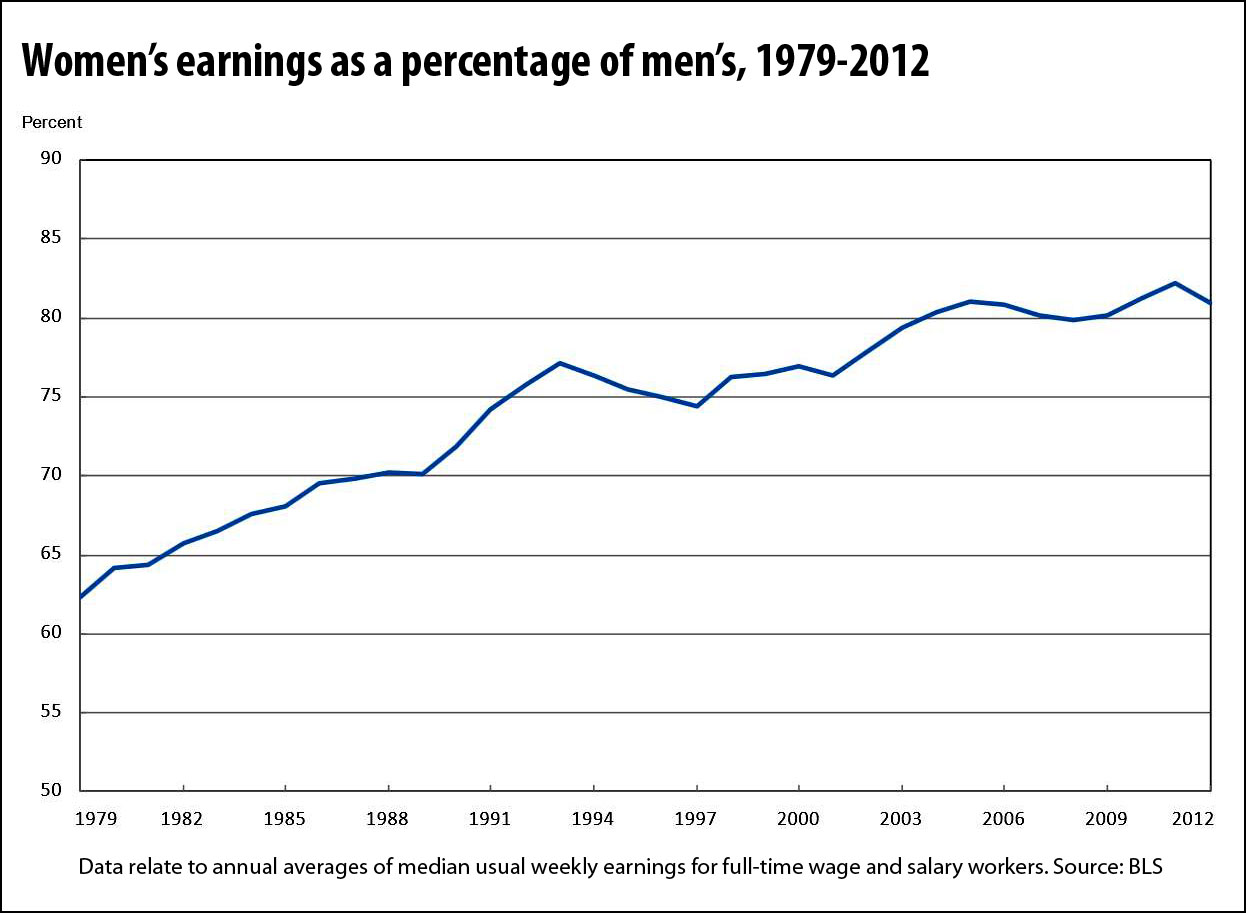Despite significant progress in recent decades, American women remain disadvantaged in terms of pay, promotion prospects and work-life balance. Other areas of concern include educational attainment and labor force participation, legal maternity rights and family-friendly workplaces, and presence of women in positions of power. According to a 2012 Census Bureau report, women make as little as 77 cents for every dollar that men earn for equivalent work. This and similar figures are often cited, but there’s a lot of nuance in the particulars, including the type of work performed and workers’ age, race and ethnicity.
In October 2013 the U.S. Bureau of Labor Statistics (BLS) released “Highlights of Women’s Earnings in 2012,” which gives a comprehensive overview of women’s earnings in the United States. Like the Census Bureau study, the BLS report is based on data from the Current Population Survey, an analysis of 60,000 representative households from across the nation. According to the BLS, in 2012 women on average made 81% of the median earnings of male full-time workers. (Note that the 81% figure does not necessarily mean that women’s earnings relative to men have increased four percentage points, only that the methodology of the Census Bureau and the BLS differed.)
The BLS report highlights the fact that while American women have made great strides in the past 30 years — they made only 62% of what men did in 1979, the first year for which comparable earnings data are available — they continue to earn significantly less than men. Moreover, as indicated in the report, the narrowing of the gender pay gap has slowed over the last decade:
The Bureau of Labor Statistics report breaks down the gender pay gap by age, race, occupation and hours worked. Findings include:
- The gender pay gap is much smaller for younger individuals. Among 25- to 34-year-olds, the women’s-to-men’s earnings ratio was 90% in 2012, compared to 75% for 45- to 54-year-olds.
- The gap is largest among Asian and white women: The median women’s-to-men’s earnings ratio is 73% for Asians and 81% for whites, compared to 90% for blacks and 88% for Hispanics or Latinos. (While this sounds like a positive for black and Hispanic women, the higher figure is in part a consequence of relatively low average earnings by black and Hispanic males.)
- Education is a key determinant of pay for both women and men. Those without a high school diploma earned on average 40% of those with a bachelor’s degree or higher in 2012, and those with a high school diploma but no college education earned 50% of those with a degree. This result holds for both genders.
- In almost every occupation, the median weekly earnings for women are consistently lower than those for men. In management, professional and related occupations, they take home 72% what men earn; in education, training and library work, the figure is 76%; women in the arts, design, entertainment, sports and media make 84% what men in those fields earn; for healthcare, the figure is 79%; in service occupations, 80%. (This holds true even at the top of the scale: A 2012 study found that female CEOs and directors earned 42% less than than their male counterparts.)
- The occupational distribution of men and women is very different. While women are more likely than men to work in professional occupations, the proportion of women employed in the higher-paying job groups, such as engineering and computing, is smaller than the proportion of men employed in them.
- At all levels of education, women’s earnings growth has been better than men’s over recent decades. For example, the real earnings of women with a college degree have risen by 28% compared to 17% for men. Even when average wages have fallen, those for women have fallen less: The inflation-adjusted earnings of women without a high school diploma have fallen 14% since 1979, for example, while those of men dropped 32%.
- Among full-time workers, men are likely to work more hours per week than women. Even controlling for the longer workweek, the pay gap remains: Among full-time workers with a 40-hour workweek, women earned only 88% as much as men on average.
- Women are more likely than men to work part time (less than 35 hours per week): 26% of all female wage and salary workers were part time in 2012, compared to 13% of male workers. Although women and men who worked part time had similar median earnings, men who work part time are on average younger than women who do so: 43% of male part-time workers were 16 to 24 years old compared to 29% of female part-time workers.
The report demonstrates that the gender pay gap still consistently pervades every segment of society — by age, race, education level, occupation type and hours worked.
A related 2013 report from the Bureau of Labor Statistics, “The American Time Use Survey,” provides insight into the challenges that women face in balancing work, family life and household chores. Among its findings: On an average day, 82% of women spent some time doing household activities, compared to only 65% of men. Furthermore, a 2013 study from the University of Alabama, “When You Just Cannot Get Away,” found that women were more likely to have negative work-home spillover, and respondents in the two lowest family income brackets had higher negative spillover than those earning more.
Keywords: women and work



Expert Commentary